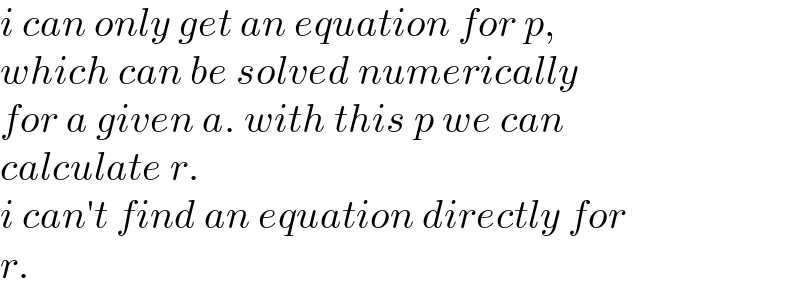
Question and Answers Forum
Question Number 165431 by ajfour last updated on 01/Feb/22

Answered by mr W last updated on 01/Feb/22

Commented by mr W last updated on 01/Feb/22

Commented by mr W last updated on 01/Feb/22

Commented by ajfour last updated on 01/Feb/22

Commented by mr W last updated on 01/Feb/22

Commented by mr W last updated on 01/Feb/22

Commented by mr W last updated on 01/Feb/22

Commented by ajfour last updated on 01/Feb/22
Yeah, even i tried n got two eqns. in r, p, a. Thanks sir, i shall chase it bit more..
Commented by Tawa11 last updated on 02/Feb/22

Answered by ajfour last updated on 02/Feb/22

Commented by ajfour last updated on 02/Feb/22
![y=(x/(2p))+c=a^2 −x^2 (tan θ=(1/(2p))) ⇒ x^2 +(x/(2p))+c−a^2 =0 x=p=−(1/(4p))+(√((1/(16p^2 ))+a^2 −c)) ⇒ p^2 +(1/2)=a^2 −c ⇒ c=a^2 −((1/2)+p^2 ) ..(i) Now r−rsin θ=r−(r/( (√(1+4p^2 )))) =a^2 −p^2 ⇒ r=((a^2 −p^2 )/(1−(1/( (√(1+4p^2 )))))) ...(ii) consider upper line y=(x/(2p))+c+rsec θ [now with ..(i)] a^2 −x^2 = (x/(2p))+a^2 −((1/2)+p^2 )+((r(√(1+4p^2 )))/(2p)) D=0 ⇒ (1/(4p^2 ))=((2r(√(1+4p^2 )))/p)−(2+4p^2 ) using ..(ii) (1/(4p^2 ))=((2(√(1+4p^2 )))/p)(((a^2 −p^2 )/(1−(1/( (√(1+4p^2 )))))))−(2+4p^2 ) ⇒ (2p+(1/(2p)))(√(2p))=((4(a^2 −p^2 ))/( (√((1/(2p))+2p))−(1/( (√(2p)))))) And r=((a^2 −p^2 )/(1−(1/( (√(1+4p^2 )))))) .](Q165492.png)
Commented by ajfour last updated on 02/Feb/22

Commented by mr W last updated on 02/Feb/22

Commented by ajfour last updated on 02/Feb/22

